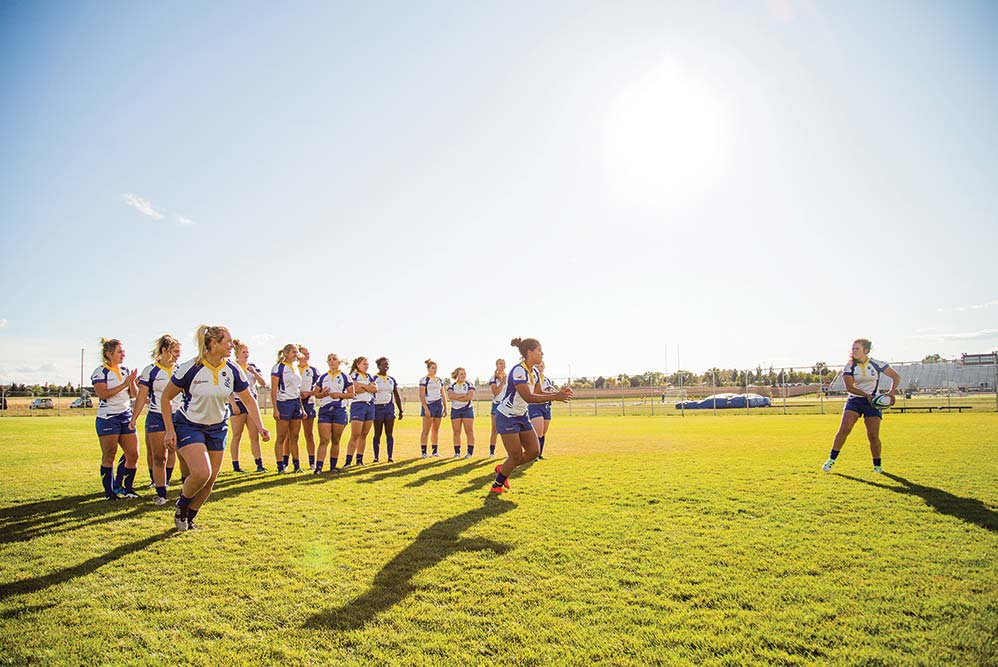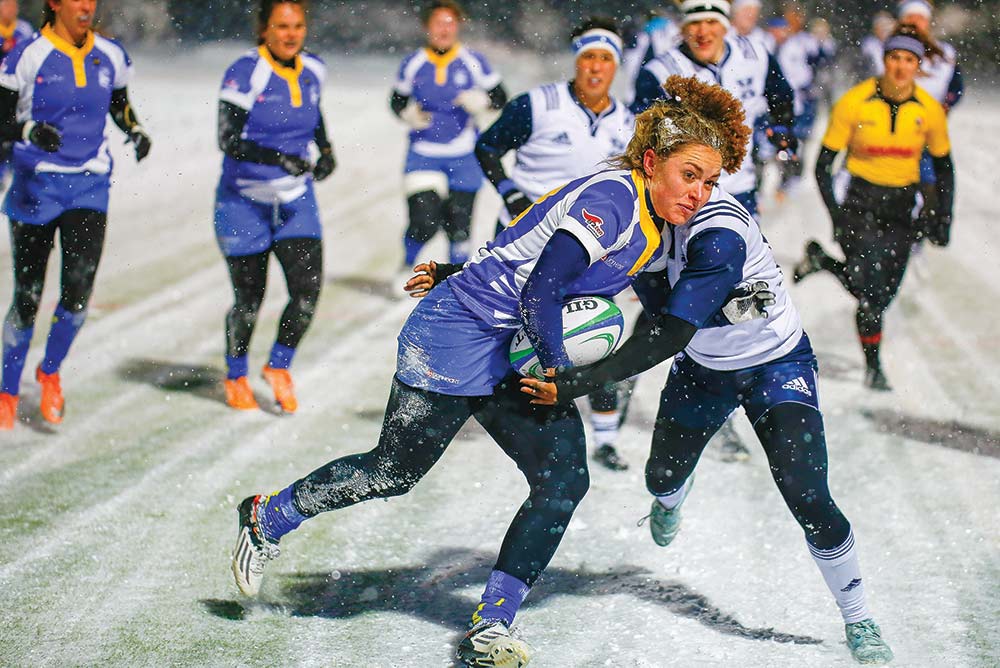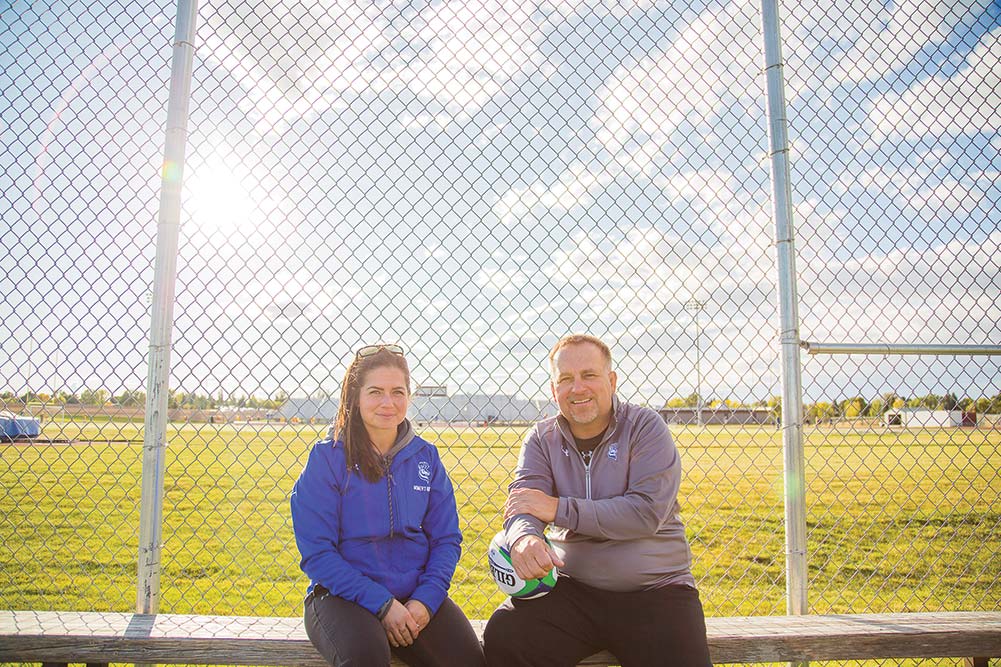Reflected in the championship banners that hang in the 1st Choice Savings Centre for Sport and Wellness, on the Pronghorns Hall of Fame wall that celebrates its three successive national titles, in the eight Academic All-Canadians on the current roster, with the five players elected to the 50 Greatest Pronghorns list and throughout southern Alberta as coaches, managers and stewards of the game in virtually every high school program — the identity is rooted in fundamental values that breed success.
“We did not foresee this, no, truly not,” says Neil Langevin (BA/BEd ’91, MEd ’10), who along with Toby Boulet (BEd ’89, MEd ’04), are credited as the principal architects of the program. “We thought we were creating an opportunity for local girls to play rugby and, to be honest, we didn’t see too much beyond that.”
Their philosophy was simple enough. With a mantra that preached process before results, they implored everyone in the program, from players to coaches to athletic therapists, to simply try and make Pronghorns rugby better today than it was yesterday — and then do it again tomorrow.

“At the end of the day, we are judged by results but you can’t get those results unless you are focused on the day-to-day process,” says Langevin, who recently returned to the program in the wake of the tragic death of head coach Ric (Sluggo) Suggitt in June 2017. “That mantra has persisted since the beginning and I’m proud to say I now work with girls who have come through the program and continue to use that approach in everything they do today.”
Success came relatively early for the program. After debuting in 1999, the Horns captured Canada West bronze in 2001 and two years later had a first appearance at nationals. A run of five successive Canada West titles would follow and from 2007 through 2009, the Horns reeled off three straight national titles. In a short 10 years, Horns Rugby became the national measuring stick.
Even more significant than what was taking place on the field was the ripple effect of Pronghorns Rugby throughout southern Alberta. Initially a fringe sport, it took time to move into the mainstream and begin attracting the region’s best athletes. Even southern Alberta’s greatest rugby product, Olympian Ashley (Patzer) Steacy (BSc ’15), had to be coaxed into taking up the game in her high school years.
“When I was in high school you weren’t getting any of the best athletes playing rugby,” says Steacy, who has returned to the program as a coach. “You were getting those who’d heard about it from a friend, or were maybe curious and wanted something new to play, but the best athletes played the more traditional sports.”
Steacy was dragged to the pitch by a close friend and implored by coaches to be more than just a practice player on her first exposure to the sport. Once she hit the field in a competitive setting, the game hooked her. She enjoyed the contact, its empowering nature and the sport’s welcoming culture.
“The camaraderie between your teammates, between you and the opposition, between you and your staff, I feel like there’s so much respect within the sport,” she says. “It’s an aggressive, fast-paced, crazy game but you’re still friends with your opposition and at the end of the day, you shake their hands and you respect them.”

Langevin says a major factor in the growth of the game, aside from the success of the Pronghorns, was the simple fact that its varsity sport status at uLethbridge gave it legitimacy in the southern Alberta sporting community.
“Just the initial move of having the University recognize rugby as a varsity sport and giving scholarships was huge,” he says. “There’s a competitive nature with southern Alberta athletes and this gave them another legitimate avenue for athletes to play at a high level. What’s also happening now is we’re not just seeing our athletes recognized at the university or provincial level, they’re being recognized nationally, so it’s much easier for girls today to see themselves in the sport and say, yes, that’s the sport I choose.”
In 2008, the Pronghorns hosted the national championship tournament and parlayed it into a showcase of the women’s game. Perfect weather, coupled with a championship performance by the home side pushed the game to the forefront and local area high schools jumped on board.
“If you look at the number of high school programs that now have both a junior and senior varsity team, even the small schools, it’s impressive. Look at the complete dominance of our high schools at the provincial level, I think that’s evidence of what was achieved through that 2008 tournament,” Langevin says of the exposure it gave the game.
When the Horns played host to the 2017 USPORTS National Championship tournament, the focus was less on educating the public about women’s rugby and more on celebrating its strengths. Both Langevin and Steacy see a completely different rugby landscape now than 10 years ago.

“It used to be where we would have maybe one or two players from the provincial team come to the program and now, the vast majority of our players have been playing for five or six years, and they’ve played at the provincial level or national junior level,” says Langevin.
The challenge now is mining the depth of talent found throughout western Canada and the centralization of national programs on the west coast. With the National Sevens program based in B.C. and talk of the 15s also centralizing on the coast, much of the country’s elite-level players are gravitating to B.C. schools.
For the Pronghorns, it translates into an even sharper focus on growing the game in southern Alberta and strengthening the home base.
“Even in the last two years, the way that Sluggo recruited, that was our philosophy,” says Langevin. “We don’t ever sell our soul looking for the high-profile recruit, we don’t promise extra stuff. We really believe that once we get players here, something magical happens in the community and at the University. We try to pick people with good character and those people find each other and we grow from there.”
Steacy says this philosophy created the platform for the national powerhouse teams of which she was a part. As much as she is wont to admit, she was the lone star of her recruiting class, but rugby success in particular isn’t predicated on individual talent.
“I think back to 2005 when our group of eight came in, there weren’t a lot of big names in that group, and through developing together and having that bond throughout the years, we found you don’t necessarily need all those big names to be successful,” she says. “It’s about establishing a culture, a trust, and a belief that you can do something special.
“There’d been about five years building the culture and defining what Pronghorns Rugby was all about before we came in. Those women really built the program and helped transfer the values of what the program stood for and set the tone for what Horns Rugby was all about from the very beginning.”
It’s a culture that is alive and well today and an identity that Steacy and Langevin are proud to nurture, not just internally but throughout southern Alberta.
“If you look at every high school program in the community, maybe with the exception of one, there is a Pronghorns rugby alumnus associated with them, and to see that legacy is very satisfying,” says Langevin. “To see the profile of our program at the University, throughout the city and southern Alberta, to be able to come into the gym and look up at those banners and what they represent, it absolutely feels awesome and is a testament to everyone who has been a part of Pronghorns Rugby over the years.”